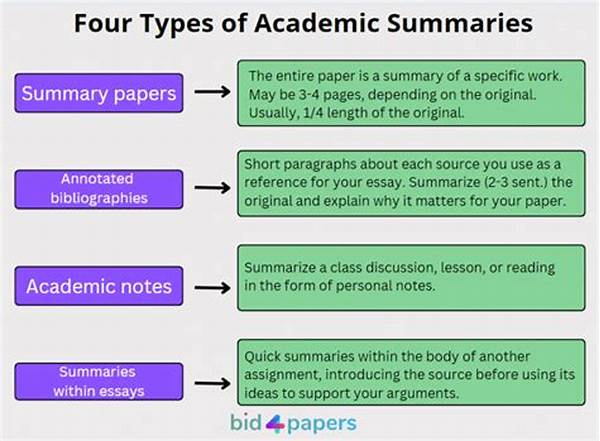In the realm of academia, the ability to summarize information concisely is crucial for the effective dissemination and comprehension of complex research. Academic summaries play a fundamental role in the communication of ideas, findings, and theories. They help bridge the gap between extensive research studies and the audience, ensuring that essential points are conveyed clearly and succinctly. Structuring concise academic summaries, therefore, is not just about reducing content; it’s about preserving the essence of the research while facilitating understanding and engagement.
Read Now : Top Citation Management Tools Comparison
Importance of Structured Summaries
Structuring concise academic summaries is pivotal in academic discourse, as it encapsulates core concepts and essential findings. This task requires the summarizer to extract critical information from comprehensive texts while maintaining coherence and logical flow. The art of summarization becomes a balancing act of distillation, wherein details are curtailed, yet the message remains intact. Therefore, summarizers must be adept at discerning which elements of the text to emphasize and which to omit.
Structured summaries aid in the efficient dissemination of research. Given the vast amount of information available, scholars and educators alike require methods to sift through content swiftly. Summaries allow for quick appraisal of works, saving valuable time and effort. Moreover, such concise exposés help in identifying the relevance and applicability of research findings, thus fostering further inquiries or practical application.
The practice of structuring concise academic summaries also serves as a critical skill for students and researchers. Through the process of summarization, individuals refine their ability to comprehend and analyze information. By regularly engaging in this effort, one develops an enhanced capacity for critical thought and a deeper understanding of the subject matter. Hence, academic summaries are indispensable tools within the educational and research spheres, encouraging precision and clarity in the communication of scholarly work.
Key Steps in Structuring Concise Academic Summaries
1. Identify the Core Thesis: Begin by pinpointing the central argument or objective of the research. A concise thesis statement sets a clear direction for the summary, ensuring that all subsequent details align with this central theme.
2. Select Pertinent Information: Extract key details that support the main thesis. This requires a careful balance—too few details may leave the summary vague, while too many can clutter the coherence intended in structuring concise academic summaries.
3. Maintain Logical Flow: Information should be presented in a logical sequence that mirrors the original document. This ensures clarity and coherence, allowing readers to easily follow the narrative.
4. Use Clear Language: Employ simple and precise language. Avoid jargon unless necessary, as this can impede understanding. Aim for clarity and brevity to enhance the effectiveness of structuring concise academic summaries.
5. Revise Thoroughly: Review and refine the draft to eliminate redundancies. This step in structuring concise academic summaries ensures that the final text is both accurate and polished, ready to convey the essence of the research succinctly.
Read Now : Effective Public Speaking Methods
Challenges in Crafting Summaries
The process of structuring concise academic summaries is fraught with challenges, especially when dealing with extensive and complex research. Ensuring the retention of the key message while trimming excess information demands skillful editing and an acute understanding of the subject. Moreover, the summarizer must be wary of introducing bias, consciously preserving the original context and intent of the research.
Additionally, communicating intricate methodologies and significant findings without oversimplification presents another hurdle in this task. Detailed research papers often contain nuanced discussions that are critical to the understanding of the study. Summarizers must diligently capture these nuances to offer a complete picture, albeit in a condensed form. Thus, the delicate balance of accuracy, clarity, and brevity lies at the heart of structuring concise academic summaries, making it a challenging yet essential endeavor in scholarly communication.
Techniques for Effective Summarization
Impact of Structured Academic Summaries on Research
Structuring concise academic summaries has a profound impact on the dissemination and application of research findings. By providing easily digestible insights, summaries facilitate informed decision-making across various fields, from policy formulation to educational strategies. These summaries enable practitioners to swiftly grasp research outcomes and apply them in real-world contexts, ensuring that scholarly work contributes meaningfully to practical advancements.
Moreover, well-structured summaries enhance the visibility and accessibility of research, broadening its reach beyond the academic community. They provide a bridge from scholarly research to public comprehension, fostering a deeper understanding of complex issues among a wider audience. In this regard, structuring concise academic summaries serves as a catalyst for knowledge transfer, bridging gaps between academia and society.
Principles of Structuring Concise Academic Summaries
Constructing effective academic summaries demands adherence to various principles. First, recognizing the audience is crucial; understanding their background and expectations guides the level of detail and complexity in the summary. Tailoring content to meet the needs and comprehension level of the intended audience enhances its relevance and impact.
The focus on objectivity is another key principle. The summarizer must maintain a neutral tone, refraining from introducing personal opinions or bias. This ensures the integrity of structuring concise academic summaries, maintaining alignment with the original research findings. Furthermore, summarizers should engage in active reading and critical thinking to grasp the core message swiftly, facilitating the concise and accurate representation of the source material.
